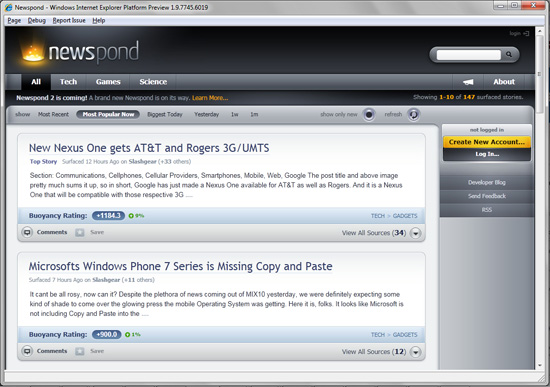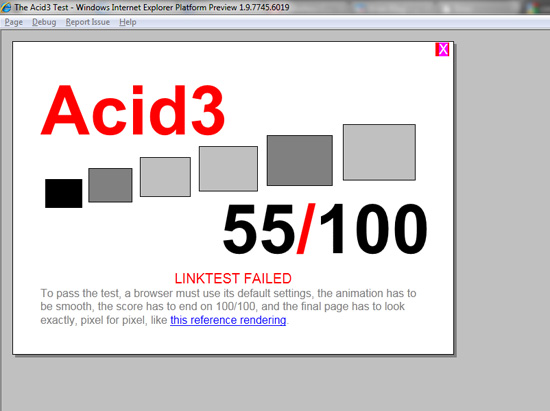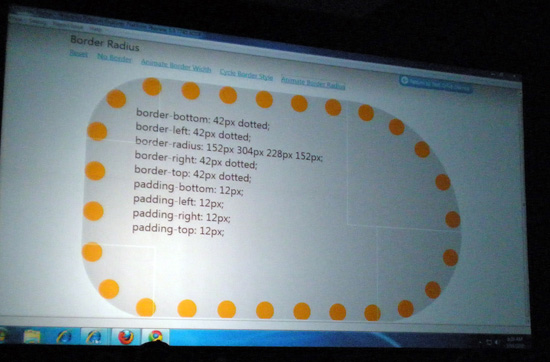Internet Explorer 9 Platform Preview: Investigated
by Brian Klug on March 17, 2010 11:44 AM EST- Posted in
- Trade Shows
Standards Compliance
That aside, virtually everything else works the way you'd expect it to. The few number of sites I visited all appeared to load (minus a few script errors) without any obvious visual problems. Among the most intense of examples I frequent is newspond.com, which uses purely CSS to deliver what I think is one of the most haptic and interactive news aggregation websites around. It's a qualitative test, but I've found that it's surprisingly real-world.

Microsoft took a quick jab at the ACID web compliance tests during the MIX10 day 2 keynote, most notably the ACID 3 test, which it currently doesn't pass:

The IE team is busy working on making IE 9 Acid3 compliant, but noted that because the HTML5 spec is still evolving, they aren't focusing exclusively on just making IE 9 pass one test. During the keynote, Dean Hachamovitch noted, "some people use Acid3 as a shorthand for standard support. Acid3 is kind of interesting, it exercises about 100 tails of about a dozen different technologies. Some of them are under construction, others less so... we will continue to make progress on the Acid3 test. The score will continue to go up as we make more of the markup that developers actually use, work."
There's something to be said for real-world testing and taking synthetic benchmarks with a grain of salt; it's something the GPU-testing community has known and practiced for years. To that extent, IE went ahead and developed its own testing suite, which you can find at http://ie.microsoft.com/testdrive/.
Dean illustrated a compelling example showing the CSS edge pattern rendering differences between the latest builds of Chrome, Firefox, and IE 9. Note as well the browser-specific prefixing required to get near the same border patterns:

Firefox 3.6 at left. Chrome (stable) at right.

IE 9 Platform Preview
This is something you can easily replicate for yourself using the latest browsers and the test pages noted previously.










60 Comments
View All Comments
phuzi0n - Wednesday, March 17, 2010 - link
Firefox already has support for this in the 3.7 prerelease builds. All of the IE9 tests that showcase the benefits of these two API's worked amazingly on my D2D+DW enabled Firefox, while Chrome fell flat. If you're interested in enabling it then see this: http://forums.mozillazine.org/viewtopic.php?f=23&a...">http://forums.mozillazine.org/viewtopic.php?f=23&a...nerdtalker - Wednesday, March 17, 2010 - link
Ooh, I did not know about this. I will definitely investigate and run a more comprehensive set of tests, including some of Opera later today or tomorrow.I'm still at MIX, so it's hectic and I won't have a chance, but getting GPU accelerated firefox in the mix is most interesting. Awesome tip!
Cheers,
Brian Klug
jrocks84 - Wednesday, March 17, 2010 - link
Just a note: you have to manually enable Direct 2D in the Firefox nightlies. There's instructions at http://forums.mozillazine.org/viewtopic.php?f=23&a...">http://forums.mozillazine.org/viewtopic...p;sid=87....chaudx - Wednesday, March 17, 2010 - link
Yep, would be nice to see results of GPU alphas of both IE9 and the FF 3.7a3 builds.Spivonious - Wednesday, March 17, 2010 - link
Your guess is correct. IE9 uses the Direct2D API, which was released with Windows 7 and backported to Vista. I don't know if it requires WDDM, but backporting it to a 10 year-old OS doesn't make much sense.haplo602 - Wednesday, March 17, 2010 - link
hmm I fired opera 10.50 on the logos test and I got 54-58fps ... however I cannot judge the quality.anyway it amazes me why MS used opera 10.10 for their charts ... given the date of the presentation, opera 10.50 was already released for cca 2 weeks. I guess it would show that they are only beating older IE versions and firefox.
BelardA - Wednesday, March 17, 2010 - link
But Opera 10.50 is on the chart as well... many are still using 10.1xOpera 10.5 fixes pretty much every problem I ever had with 10.0~10.10.
So, guess we'll see IE9 in about 1-2 years, by then Opera 11 and Google 10 will be out.
So far, not impressed with IE9... nor IE8 of course. If IE9 is going to be an improvement, it needs a total interface change, IE7~IE8 are the worst design ever.
taltamir - Thursday, March 18, 2010 - link
you mean google 100 :Poverzealot - Thursday, March 18, 2010 - link
You'd think that software developers would be smart enough to NOT REMOVE trailing 0's, especially from version numbers.erple2 - Thursday, March 18, 2010 - link
Wait... That trailing 0 is important. We've released version 5.9, then 5.10 and then 5.11 of our software.